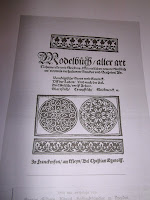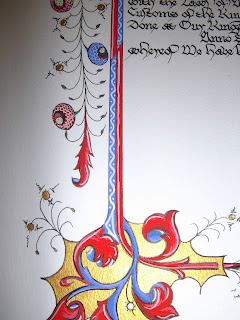Elizabethan, Tudor and Renaissance inspired embroidery, clothing and accessories - historical costuming, embroidery and re-creation
Tuesday, December 24, 2013
Button Making
One of my holiday/New Year projects is to get a whole lot of woven buttons made.
1 down, LOTS to go....
Sunday, December 15, 2013
No-sew
So much for my last post; I have been having trouble with my eyes and have not been able to do any close work for more than 3 weeks. That to-do pile is getting bigger!
Sunday, December 1, 2013
Update - end of year rush
As is it is so often at this time of the year, mundane life is very hectic. I have a new version of the purple tourney dress on the go: hopefully the bodice will fit and look better. I also have another dress partly done that has been sitting in the to-do pile for more than 6 months. There are lots of competitions that I would like to enter, Scribal works to be finished, tons of embroidery to do - and I am spending most of my time finishing off assignments and online study. Roll on December Break!
Friday, November 15, 2013
Split stitch napkin
A lot has been going on in mundane life recently, but I did manage to get a napkin embroidered in split stitch:
Wednesday, November 13, 2013
Awfully tempting mules!
Check out these beautiful mules from American Duchess:
They really are awfully tempting! AND on special at the moment as a pre-order......
http://www.american-duchess.com/shoes-18th-century
Friday, November 1, 2013
Friday, October 18, 2013
'Lost' da Vinci portrait of Isabella d'Este
Check out this article on a portrait of Isabella dÉste (probably) by Leonardo da Vinci:
http://www.medievalists.net/2013/10/07/leonardo-da-vinci-painting-discovered-in-swiss-bank-vault/
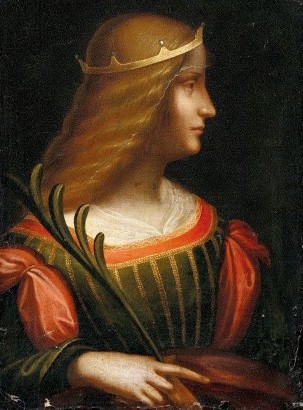
Thursday, October 17, 2013
Purple Tourney Dress
I needed a new tourney dress, and wanted one that I could wear without a corset. (My health problems mean that often I can't wear very restrictive garments like a corset, and sometimes one just needs to be able to do more than a corset allows.) I decided that a short-waisted Italian style like those popular around 1500 would be ideal.
'The Betrothal' by an Unknown Artist c. 1490
from: http://www.oceansbridge.com/oil-paintings/product/93934/dieverlobungenglishtitlethebetrothal

'The meeting of the betrothed couple' by Carpaccio c. 1495
from: http://www.oceansbridge.com/oil-paintings/product/54796/carpacciomeetingofthebetrothedcoupleandthedeparture

'Portrait of a Venetian Lady' in the style of Albrecht Durer
from: http://www.artnet.com/magazineus/features/jeromack/velazquez-rediscovered12-16-09_detail.asp?picnum=8

Detail of "The Legend of St Ursula' by Carpaccio, 1495-1500
from: http://tomclarkblog.blogspot.com.au/2013/01/john-ruskin-on-carpaccios-dream-of-st.html
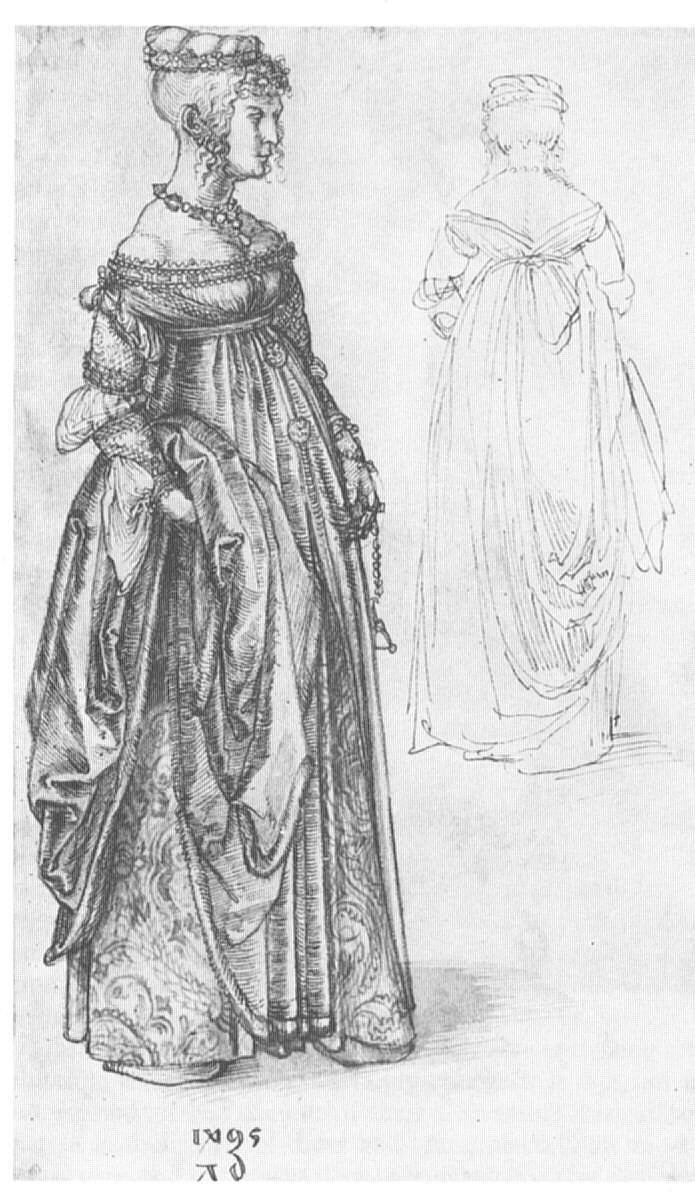
Drawing of a Venetian Lady by Albrecht Durer 1495
from: http://www.uvm.edu/~hag/sca/16thital/durer-vene1495-1.jpg
I had some purple drill that would be ideal for the project. I adapted one of my existing Italian patterns, reducing the length and making it front-lacing for ease of dressing. I usually wear a pair of boned bodies under my gowns, but for this one I decided to bone the gown bodice itself.
I used a cotton canvas interlining and a new type of plastic heavy duty boning that I have not tried before. I machined casings in the interlining fabric and used fourteen plastic bones. The top edge was machine stitched, but I did the rest by hand.
I added a black feature panel at the front of the gown and edged it with black bias tape and hand dyed brown ric rac braid. I did a running stitch along the bias in a matching brown embroidery floss, and added detached button hole stitch ovals between the peaks of the ric rac braid. (I opted not to use the additional purple braid shown in the picture above.)
The skirt was pleated on and secured with a line of machine stitching for extra strength (as I have a habit of stepping on my skirts when carrying tourney furniture to the car.) I tacked the bodice together before hanging the gown up for the hem to drop. After it had hung for a few weeks, I secured the bottom edge of the bodice with hand stitching.
 The next step was to add eyelets for lacing and lucet some cord to lace with. I added some hooks and eyes and a modesty placket. I finished the embroidery on the skirt trim and whip stitched the front edge closed.
The next step was to add eyelets for lacing and lucet some cord to lace with. I added some hooks and eyes and a modesty placket. I finished the embroidery on the skirt trim and whip stitched the front edge closed.
The skirt has a much smaller hem than usual. I will probably add a hem guard in the future for extra durability. I am also working on a set of tie-on sleeves.
The gown is very comfortable and easy to move in. I will post photos when it is totally finished.
Tuesday, October 1, 2013
Medieval cooking - Recipe fore Broad Bean Fritata
This recipe for a Bean Omelette or Friger la Fava comes from Libro de arte coquinaria as reproduced in The Original Mediterranean Cuisine. I wanted to try this recipe because I had never eaten broad beans before and wasn't sure if I would like them. (Turns out that I do!)
The recipe in the book is:
1 cup of fresh or frozen broad beans
half an onion finely chopped
1 tb olive oil
1-2 slices of pancetta, cut into strips
1 tb chopped parsley
4-6 sage leaves, finely chopped
3 eggs
salt and freshly ground pepper
The original recipe also adds chopped figs. I couldn't get fresh figs or get any pancetta, so I substituted prosciutto and omitted the figs altogether. If I did this recipe again I would use a greater amount of prosciutto or possibly bacon (just because it has a strong flavour and is easy to obtain.)
I used
1.5 cups of broad beans (frozen and thawed)
1 onion
100 g prosciutto
6 fresh sage leaves
1 apple
12 eggs
one quarter teaspoon of paprika
one quarter teaspoon of nutmeg
1-2 tb dried parsley
pepper and salt to taste
small amount of olive oil
I cooked the broad beans on salted water. I diced the onion and cooked it until it was soft in a little bit of olive oil. Then I added the diced prosciutto. I added the diced apple. I finely sliced the sage and added it to the pan. I removed one third of the bean 'skins' and chopped the beans, adding them to the pan right at the end (as they were already cooked.
In a separate dish, I beat the 12 eggs and added sweet smoked paprika, nutmeg, pepper and salt and the dried parsley. I added the apple, onion and prosciutto mix from the other pan and mixed it all together. I decided to cook this dish as a frittata for ease of serving, so lightly sprayed a frittata dish with olive oil spray and added the eggy mix. I cooked the dish for about 20 minutes at 170 degrees C. When the top was golden and the centre was firm, I took it out and cooled it on a cooling rack.
I prefer my egg dishes quite firm, but this could be cooked less to make it a little more gooey. The amounts of ingredients I used made a small and large frittata.
This dish would be really delicious with garlic and cheese added.
Monday, September 30, 2013
Edwardian shoes from American Duchess
Another posting of delicious vintage shoes from American Duchess:
http://americanduchess.blogspot.com.au/

http://americanduchess.blogspot.com.au/

Reference Notes - Images of Squirrel in Medieval and Renaissance Art
I recently did some research on squirrels in Medieval and Renaissance art to help me design my embroidered German brustfleck. Here are some of my notes.
Squirrels in imagery have had various symbolic meanings throughout the ages. Sometimes they were seen as symbols of grasping covetousness, and at other times they were seen as an affectionate friend. (Biographer Jonas of Bobbio describes Saint Columbanus of Ireland as having a squirrel companion.) (Ref: http://www.abbeville.com/blog/?p=390)
The squirrels' sensible hoarding of food for winter was not properly understood and was considered greedy.
Squirrel fur was used widely in clothing. Squirrel fur was also depicted in heraldry. Vair is the representation of patches of squirrel fur in an alternating pattern.
See http://en.wikipedia.org/wiki/Vair for more information.
Image of Squirrels in De natura rerum by Thomas of Cantimpre
Dutch translation by Jacob Van Maerlant, Flanders, c. 1350
Koninklijke Bibliotheek, The Hague, MS KA 16, 11 x 11 1/4 in. (27.8 x 20.8 cm)
Folio 68v: Squirrels

Image from: http://www.abbeville.com/blog/?p=390

Image taken from Pinterest, from the page of Scrolls and Scribal SCA http://pinterest.com/pin/52565520621769458/
The page is from a fourteenth century Book of Hours in the Beinecke Libarary Collection of Yale University. Beinecke MS 657.
Also http://sunsite3.berkeley.edu/hehweb/index2.html
Unspecified Medieval Manuscript Fragment

Image from: Pinterest http://pinterest.com/pin/277393658271781988/
Medieval Tile Fragments from Malmesbury Abbey
Image from: http://www.flickr.com/photos/29320962@N07/6203279058/
Squirrel Sculpture

Image from: http://www.scalarchives.com/web/dettaglio_immagine.asp?idImmagine=0046332&posizione=1&numImmagini=1&prmset=on&ANDOR=and&xesearch=0046332&ricerca_s=0046332&SC_PROV=RR&SC_Lang=ita&Sort=8
This image is from a Baptistry door frame in Florence and dates from the early Renaissance. It was created by the artist Lorenzo Ghiberti (1378-1455). Please see the SCALA archives for more lovely images and information.
Two Squirrels by Albrecht Durer (1492)

Image from: http://commons.wikimedia.org/wiki/File:Durer-ecureuil.jpg
Albrecht Durer (1471-1528) was a German printmaker, painter, mathematician, theorist and engraver. He is famous for his engravings, religious works and meticulously detailed natural imagery. More information is available at http://en.wikipedia.org/wiki/Albrecht_D%C3%BCrer
Page from 'Lart de bien viure et de bien mourir' in the Rare Book and Special Collections Division of the Library of Congress (P342)
LC control no. 48033846

Image from: http://lcweb2.loc.gov/cgi-bin/ampage?collId=rbc3&fileName=rbc0001_2004rosen0424page.db&recNum=341
Portrait of a Lady with a Squirrel and a Starling by Hans Holbein The Younger (1526-28)

Image from: http://commons.wikimedia.org/wiki/File:Hans_the_Younger_Holbein_-_A_Lady_with_a_Squirrel_and_a_Starling_(Anne_Lovell%3F)_-_Google_Art_Project.jpg
This oil painting was done on an oak panel and is believed by some to depict Anne Lovell. The sitter wears Tudor clothing.
Portrait of a Lady with a Squirrel by Francesco Montemezzano

Image from: http://starlightmasquerade.com/PortraitGallery/Ladder-Laced-Venetian/inspiration-pages/openbodice22.htm
Embroidered Bookbinding for the New Testament c. 1635
Further references to explore:
Animals in Medieval Art - Met Museum
http://www.metmuseum.org/toah/hd/best/hd_best.htm
Reframing Medieval Art: Difference, Margins, Boundaries by Madeline H. Caviness
http://dca.lib.tufts.edu/caviness/chapter3.html
Saturday, September 28, 2013
Pompadour Court Shoe
Another drool-worthy shoe from American Duchess is now available:
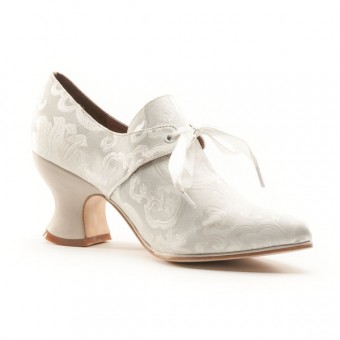
I'm having visions of spangled fans, beautiful fabrics, gilded everything and tons of diamonds!
Details are available from http://www.american-duchess.com/shoes-18th-century/pompadour-french-court-shoe-white
Medieval cooking - Sauce Galentyne and Powme Dorrys
In the last six months or so, I have become quite interested in medieval and renaissance cooking, and have been trying my hand at a few recipes. I am particularly interested in recipes that I am unfamiliar with or which contain ingredients that I have not tried before.
I made Powme Dorrys and Sauce Galentyne in August. The recipes come from Liber cure cocorum - which can be found online at http://www.pbm.com/~lindahl/lcc/
Sauce Galentyne
"Take crust of bread and grind it small, take powder of galingale and mix with all,
Powder of ginger and salt also; Mix it with vinegar ere you do more,
Draw it through a strainer then, And serve it forth before good men."
I used:
1 and a quarter cups of white wine vinegar
1 tsp salt
1 tsp ginger
1 cup of white wine
70g chopped and pounded fresh galingale
1 and a quarter cups of breadcrumbs
three quarters of a teaspoon powdered cinnamon.
The cinnamon and wine were added because they show up as ingredients in other versions of Sauce Galentyne recipes (e.g. p. 562 of Take a Thousand Eggs or More Vol. 2- from Ashmole MS 1439 and Harleian MS 4016.) I thought these ingredients would make for a richer sauce.
I was unable to obtain powdered galingal, so had to use the fresh root. Pounding fresh galingal is not an easy task. The piece I obtained was quite fibrous and woody. I believe that this sauce is normally a pink colour. Mine turned out beige coloured; I think because of the fresh galingal. Next time I make it, I might reduce the vinegar by a quarter of a cup.
I mixed the ingredients and let them soak, then passed the mixture through a sieve.
I wanted to try this sauce because it sounded interesting; I couldn't imagine that it would taste very nice. Although it tended to separate in the serving dish, it was actually a really tasty and piquant sauce that would be great with any meat. My family are unaccustomed to medieval flavours but were really impressed with this sauce as well.
I made Powme Dorrys and Sauce Galentyne in August. The recipes come from Liber cure cocorum - which can be found online at http://www.pbm.com/~lindahl/lcc/
Sauce Galentyne
"Take crust of bread and grind it small, take powder of galingale and mix with all,
Powder of ginger and salt also; Mix it with vinegar ere you do more,
Draw it through a strainer then, And serve it forth before good men."
I used:
1 and a quarter cups of white wine vinegar
1 tsp salt
1 tsp ginger
1 cup of white wine
70g chopped and pounded fresh galingale
1 and a quarter cups of breadcrumbs
three quarters of a teaspoon powdered cinnamon.
The cinnamon and wine were added because they show up as ingredients in other versions of Sauce Galentyne recipes (e.g. p. 562 of Take a Thousand Eggs or More Vol. 2- from Ashmole MS 1439 and Harleian MS 4016.) I thought these ingredients would make for a richer sauce.
I was unable to obtain powdered galingal, so had to use the fresh root. Pounding fresh galingal is not an easy task. The piece I obtained was quite fibrous and woody. I believe that this sauce is normally a pink colour. Mine turned out beige coloured; I think because of the fresh galingal. Next time I make it, I might reduce the vinegar by a quarter of a cup.
I mixed the ingredients and let them soak, then passed the mixture through a sieve.
The strained sauce.
The Powme Dorrys or Glazed Meatballs seemed perfect to go with this sauce.
Powme Dorrys (also from Liber cure cocorum)
"Take pork and grind it raw, I teach,
Mix it with beaten eggs; then
Cast powder to make it in a ball;
In boiling water you shall cast it
To harden, then you take,
Spit it fair for God's sake.
Baste it with yolks of eggs then
With a feather at fire, as I teach you;
Both green and red you may make it.
With juice of herbs I undertake;
Hold under a dish that naught be lost,
More commendable it is
as well you know."
I substituted chicken mince for pork mince as many people in my barony do not eat pork. I added small amounts of salt and pepper, and used rice flour as the powder to "make it in a ball". A wise friend who tasted the dish suggested that the "powder" mentioned in the recipe may have been Powdre Douce or a similar spice/seasoning powder commonly used in medieval cooking. Once she mentioned it, I couldn't believe that I hadn't thought of it. Using Powdre Douce or similar would make these meatballs much tastier. On their own they were a little bland (but very good with the sauce above.) I would also like to try this again using pork mince for a richer taste.
I used:
1 kilogram of chicken mince
One quarter cup of rice flour
salt and pepper to taste
extra rice flour for rolling
2 eggs to bind
2 egg yolks for basting
(makes approximately 55 rum-ball sized balls)
Mix flour, mince, 2 eggs and salt and pepper to an even consistency. Make small balls with hands and roll lightly in the extra rice flour. carefully drop balls into a shallow pan of boiling water and boil for 10-15 minutes (depending on size of ball and whether doing in one or two batches.) When cooked, drain.
Add cooked balls to a bowl containing well beaten egg yolks and coat until all balls are yellow. I fried mine lightly in a small amount of olive oil.
I omitted the herb juice dressing at the end because all I had at the time was spinach and sage, and because I planned to serve them with a sauce anyway.
These meatballs would also be good with garlic and onion powder added and cooked in chicken stock instead of water.
The boiled meatballs being coated with egg yolk prior to frying.
The fried meatballs showing lovely colour and slightly crisped surfaces.
Saturday, September 14, 2013
Trefoil Pattern Linen Pouch
I have been working on a linen presentation pouch. I am using the new fine wool that I purchased recently. This is my first attempt at any sort of wool work. The trefoil design is being worked in split stitch. I intend to fill in the leaves once all the outlines are done.
All the other projects that I am working on are surprises for other people, and I can't post pictures until they have been presented.
Monday, September 9, 2013
More packages!
Another lovely package arrived; this time it was a beautifully wrapped package of embroidery wools from The Orange Daisy. I will post pictures of what I do with them.
Saturday, September 7, 2013
Nice surprise!
Look at what came in the mail recently! It is full of lovely coloured plates and will be very useful as inspiration for illumination.
Wednesday, September 4, 2013
Current projects
I haven't been posting much lately, but I have been busy. I have been working on several items for other people. (I will not be able to post about them until they have been presented.)
Another big project that is taking a lot of my time is preparing research notes for publication on my blog. I spend an awful lot of time researching imagery to support decisions I make in creating the things that I make, so I thought that I should collate my notes and post them so that they can help other people as a starting point for their own research. But it is proving to be a BIG job!
Another big project that is taking a lot of my time is preparing research notes for publication on my blog. I spend an awful lot of time researching imagery to support decisions I make in creating the things that I make, so I thought that I should collate my notes and post them so that they can help other people as a starting point for their own research. But it is proving to be a BIG job!
Tuesday, September 3, 2013
More drool-worthy shoes
Check out these wonderful 1930's Oxford shoes available on special (pre-order) from American Duchess. That store, with all those beautiful shoes, is almost enough to tempt me to branch out into costuming from later periods!
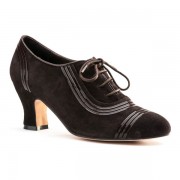
from: http://www.american-duchess.com/shoes-1920s-1930s

from: http://www.american-duchess.com/shoes-1920s-1930s
Thursday, August 15, 2013
IRCC3 - August Update
Well, this final month of the Challenge flew past! I didn't manage to complete much, but I am pleased with what I have achieved.
I have a new adapted gown pattern, and a gown cut out ready to sew.
I have a new adapted coat pattern, and a coat partially sewn.
I have a set of large pockets mostly finished.
I have a terracotta red silk underskirt completed and awaiting some embroidery.
I have a partially sewn chemise.
I have a lovely new feather fan.
Plus all the semi-completed and finished products from the earlier months of the Challenge.
This is much more than I would normally achieve in a year, and more than I thought I could achieve, so I am very happy with my progress. (I will post pictures and details of items as they are finished.)
Best of all, I have really enjoyed learning from and being inspired by the other participants in the Challenge. My confidence has improved and I feel very motivated.
Sunday, August 11, 2013
To Surf Or Not To Surf
As you all know, I tend to work slowly and erratically on projects. And I suffer terribly from that most SCA-ish affliction of wanting to do everything, right now. Obviously, the two tendencies don't really compliment each other. I am wondering if I should just stop surfing the net, and focus on the projects that I already know that I want to do, and leave the distractions for that time when - miraculously- I will be up to date, with free time. Oh no - my internet provider will probably lose so much money that they will go out of business!
Saturday, August 10, 2013
Monochrome Collar and Cuffs - Shirt Presentation
You might remember that earlier this year I was working on some red monochrome embroidery on linen for a shirt. Well, back in June I had a very nice surprise; my friend had made up the shirt that the embroidery was destined for. She did a great job, and the shirt was presented in court as a surprise gift.
Here are some pictures from my earlier posts about the embroidery:
The pattern from Modelbuch Aller Art
The finished embroidery
Many thanks to Clair Abrahams for the photo of the completed shirt.
Friday, August 9, 2013
AoA Scroll Blank #1
Recently I have been working on my first scribal assignment; colouring an Award of Arms scroll blank.
The blank was designed by Master Richard de la Croix and is derived from a 1440 manuscript fragment. The blank shows a bastard Gothic hand which was very popular on the continent and in England in the fifteenth century.
I opted for classic red, blue and gold treatments. This excellent book given to me by my sister has been invaluable as a design reference, as it has many close-up pictures of extant manuscript pages in similar styles:
And here is my attempt. Unfortunately the colours really haven't shown up very well on the photos.
The blank was designed by Master Richard de la Croix and is derived from a 1440 manuscript fragment. The blank shows a bastard Gothic hand which was very popular on the continent and in England in the fifteenth century.
I opted for classic red, blue and gold treatments. This excellent book given to me by my sister has been invaluable as a design reference, as it has many close-up pictures of extant manuscript pages in similar styles:
And here is my attempt. Unfortunately the colours really haven't shown up very well on the photos.
(Of course I can't show the name or device or it wouldn't be a surprise!)
Subscribe to:
Comments (Atom)




























